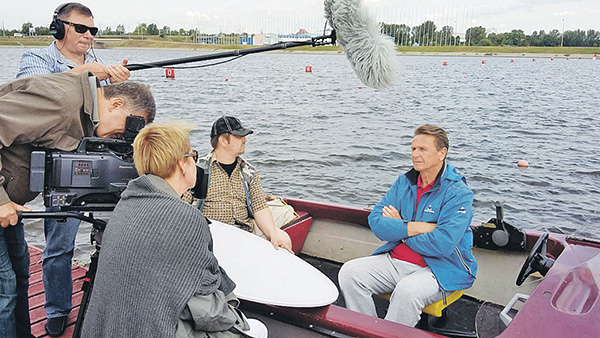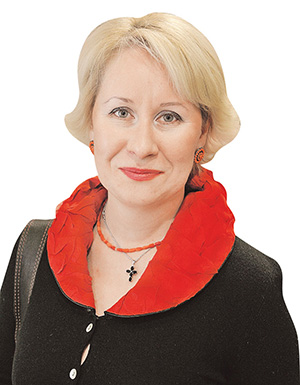The film has nothing in common with official movies which are commonly shot as part of state requests in the documentary genre. It was shot at the Belarusfilm Studio to mark the Presidential elections, under the banner of the Culture Ministry. The film is not rose-tinted, Belarus and its people are depicted as they are, without exaggeration, propaganda or beautification. Audiences have thanked the director for the positive attitude and warmth contained within the film. Work such as this is natural for Galina Adamovich. She shuns run of the mill documentary styling and, in this recent work, the director demonstrates how the country has changed in twenty-five years.

One of the high points of the film is a story about a team of rowers from Mozyr with whom Vladimir Shantarovich, head coach of the Belarusian national canoe/kayak team, works. His team easily defeat their rivals from Germany and Hungary, where rowing is a national sport. How they manage to do this is a riddle that Galina Adamovich was trying to solve
Folk elite
It’s a challenge to mention so many events from all different areas life in just 52 minutes. How did you begin to plan your work?
This is the key issue: what principle should be behind a film. In a sea of positive events, there were also things to be remembered with sorrow: the explosion in the Minsk metro and the Nemiga congestion. We thought about it for a long time and, eventually, the Deputy Culture Minister, Irina Driga, proposed that we visit the Sovetskaya Belarus’ Editor-in-Chief, Pavel Yakubovich. During our meeting, we discussed the structure of our film and the idea was born.
This film depicts everything that the documentary makers have seen. Kilometres of film were used, but we’ve chosen the most important, interesting and significant events from those shot by Stanislav Gaiduk, Victor Aslyuk, Mikhail Zhdanovsky, Yuri Gorulev, Nikolay Knyazev and Sergey Katier. The film is subjective and this has been my conscious choice. I think my colleagues would have done the same. I tried to choose the parts that describe our progress.
How did you manage your task?
Ideally, the whole team of journalists should work on such films; they study situations and people. On this occasion, I acted as scriptwriter, director and host. It was necessary to decide quickly who would be shot at a nuclear power station, how filming would be organized at a cardio-surgery department and what agro-complex would be featured in Grodno or Brest Region. I was carried away with the whole film and really enjoying communicating with all those people; they produced a great energy. These are the true elite of our society.
People with nuclear energy
What part of the filming was the most important for you?
 It was most important for me to work at the Ostrovets nuclear power station as I had an ambiguous attitude to it. I know this part of Belarus well: Ostrovets District in Grodno Region, close to the Lithuanian border. I shot many films there. This is a beautiful part of Belarus and I have never liked the idea that a nuclear power station would operate here. Every Belarusian remembers the Chernobyl disaster well and it seems wise to do without any nuclear power stations. However, on studying the issue, we see that many such power stations work around the world, including those in America and France. We do need to resist our prejudices.
It was most important for me to work at the Ostrovets nuclear power station as I had an ambiguous attitude to it. I know this part of Belarus well: Ostrovets District in Grodno Region, close to the Lithuanian border. I shot many films there. This is a beautiful part of Belarus and I have never liked the idea that a nuclear power station would operate here. Every Belarusian remembers the Chernobyl disaster well and it seems wise to do without any nuclear power stations. However, on studying the issue, we see that many such power stations work around the world, including those in America and France. We do need to resist our prejudices.When we came to the station, several major stages were already finished and had not been filmed at all. This is a problem of modern cinema: in Soviet times, construction sites of the kind were always recorded in a documentary. The situation is different now. TV workers come, ask a couple of questions and broadcast just 90 minutes as a result. It is not only the first Belarusian nuclear power station to be built in Ostrovets: a new era in Belarus’ nuclear energy is being created. When five thousand strong men work day and night — showing huge effort — it must be filmed. It would be great to see how everything develops in 15-20 years.
Does this mean that the filming made you change your opinion on nuclear energy?
I have no reason not to believe Anatoly Bondar, chief engineer at the Ostrovets nuclear power station, born in the small Polesie town of Petrikov, when he says that reactors are safe. He explains that 58 reactors operate in France and I can’t see why they should not work in Belarus. Our specialists are just as highly qualified. For example, Mr. Bondar worked at a small reactor at the Scientific-Research Institute, near Minsk. The Chernobyl disaster then occurred. When new water-cooled power reactors were invented (three years before the Chernobyl tragedy), he moved to the Balakovo nuclear power station, on the Volga River. On receiving Russian citizenship, he began constructing nuclear power stations in Iran, India and China. As a Russian specialist, he was invited to head the Belarusian construction work.
There are still patriots
What’s happening with Belarusian documentary films?
We shot 13-minute long films which aren’t really long enough to develop the whole story. People are keen to trace other people’s destinies and would like to see this in the full course of time. However, we’re only offered the chance to make short films which, unfortunately, no one appreciates. Even 52 minutes are not enough for a documentary to tell a big story.
One of the high points of the film is a story about a team of rowers from Mozyr with whom Vladimir Shantarovich, head coach of the Belarusian national canoe/kayak team, works. His team easily defeat their rivals from Germany and Hungary, where rowing is a national sport. How they manage to do this is a riddle that Galina Adamovich was trying to solve.
Your film is rather patriotic. How do you view the notion of ‘patriotism’ in the documentary?
It’s usual for the intelligentsia to be in opposition to the existing power. However, it’s always easier to criticize than to do something proactive isn’t it? The same refers to space. We were all laughing when the first Belarusian satellite failed… how can Belarus be a space nation! However, when I became acquainted with the academic, Sergey Zhdanok, and listened to him talk, I learnt how it was in reality and how the engineers of the Belarusian Peleng enterprise were working to create an optic-electronic telescope for our satellite, I stopped laughing.
Today, when the Director of the National Academy of Sciences’ Geoinformation Systems enterprise, Sergey Zolotoy (responsible for flying the second satellite and for the launch of the third satellite) says that ‘we’ll show our true worth soon’, I have no reason not to believe him.
By Nina Kataeva
Profile
Galina Adamovich is the author of over twenty documentaries; most of them have been acknowledged at domestic and foreign film festivals. Her My God (2005) received the prize of the best short documentary in Karlovy Vary, while Zavedenka (2007) was named the best Belarusian national film.











